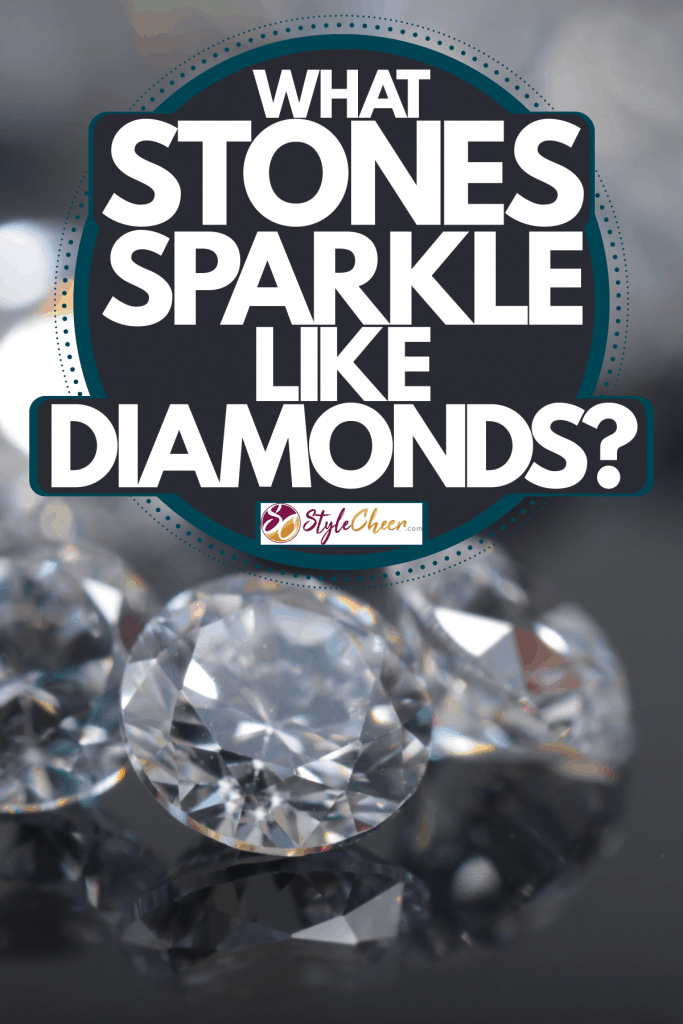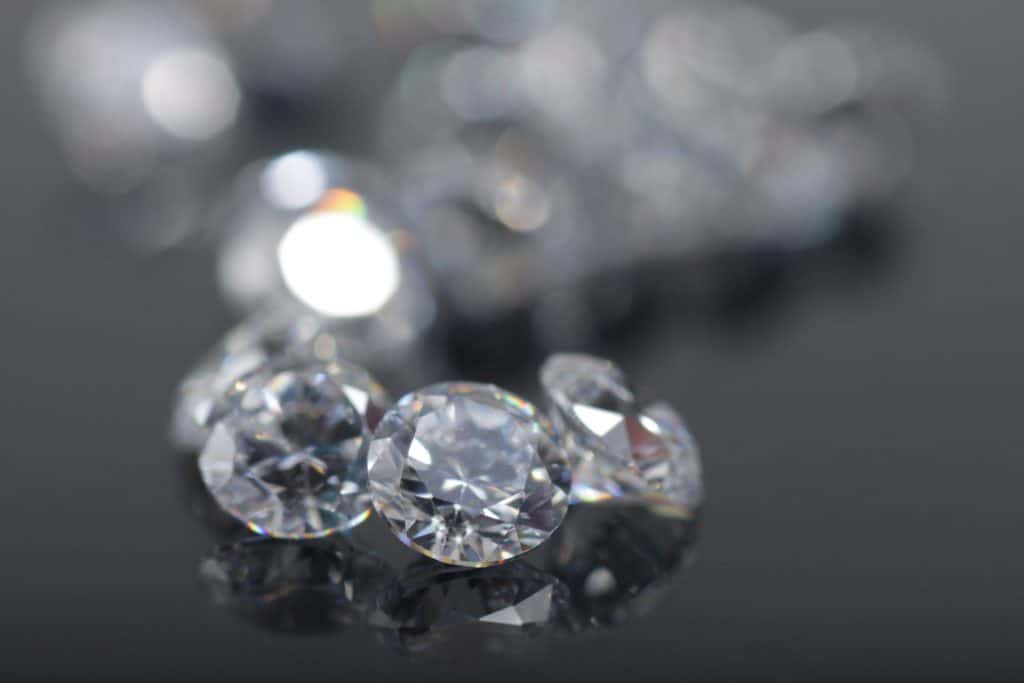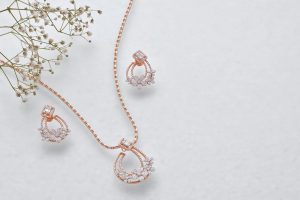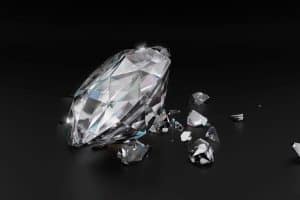Want the look of a diamond but don't know which stones have similar qualities and characteristics? We have done some research and found many stones that sparkle like diamonds. Keep reading to find out more information about popular diamond alternatives.
There's nothing quite as eye-catching as light hitting a diamond, creating an explosion of sparkle. However, there are other stones, some natural and some lab-created, with the same flicker. If you are searching for other clear stones that offer shimmer and shine, consider the following alternatives:
- White Sapphire
- White Topaz
- White Zircon
- Quartz
- Goshenite
- Cubic Zirconia
- Moissanite
- Glass
Diamond alternatives are gaining popularity for many reasons. Each of these beautiful stones has visual similarities to diamonds. This article will take a closer look at several clear stones that you might choose instead of diamonds. We will highlight the features of each one to give you useful information. We will also answer some popular questions about suitable replacements to help you make an informed decision.

This article may include affiliate links and elements that were carefully created by our team using advanced ai to help you envision the best style advice.
What looks like a diamond but is cheaper?
There are many clear stones to substitute for diamonds saving you money with a comparable look. Below is a list of natural and lab-created stones that are considered diamond alternatives. Learn more about each to see which one you might prefer.
Natural Stones
White Sapphire
White sapphire is the colorless or white form of corundum. It's naturally mined and lab-created. The white sapphire has a softer look than a diamond but sometimes has blurred coloring. It lacks the sparkle and contrast of light and dark of a diamond but has its own type of glow. White sapphire is durable and hard, although not as hard as diamonds. The cost is considerably less, which allows for choosing a high-quality large carat with a smaller budget.
Find this engagement ring with 2.50-carat cushion white sapphire center on Amazon.
White Topaz
White topaz is softer than diamonds, moissanite, and sapphires but is more durable than many other stones. It can be scratched, which will dull the appearance over time. The clarity and color between the two are very similar, but the brilliance is different. With a much lower refractive index than diamonds, there will still be plenty of sparkles but not identical to a diamond. However, white topaz is a budget-friendly gemstone that will draw lots of attention.
Find these Gem Stone King 925 sterling silver white topaz leverback earrings on Amazon.
White Zircon
White Zircon is a natural stone from zirconium silicate that is often confused with synthetic cubic zirconia because of the similarity in name. A white zircon can be confused with diamonds based on appearance alone due to a very similar brilliance and a refractive index. However, it's softer and less durable, but the low cost allows for replacement.
Find this pear cut natural zircon platinum plating 925 sterling silver engagement ring on Amazon.
Clear Quartz
Clear quartz is very common and one of the most affordable gemstones. It's full of beauty, but with a refractive index much lower than diamonds, the brilliance is going to be quite different. Quartz reflects light in a manner that is referred to as a twinkle more than a sparkle. Quartz is softer than most others stones discussed in this article, so it isn't the best choice for everyday jewelry.
Find this Paz Creations sterling silver clear quartz and rose tennis bracelet on Amazon.
Goshenite
Goshenite is a gemstone from colorless beryl. It lacks brilliance and fire unless the cut is faceted very well. It's not the most convincing diamond alternative, but it is still full of natural beauty. It's also durable, affordable, and natural. So it's a good choice if you want a stone outside the mainstream.
Find this handcrafted goshenite necklace on Amazon.
Lab-Created Stones
Cubic Zirconia
Cubic zirconia is a lab-created crystal derived from powdered zirconium oxide. It's an inexpensive and widespread diamond replacement but is easily detected as fake. While it has glamour, it has no real value. Any value in a jewelry piece containing cubic zirconia would come from the value of the metal setting.
Find these WEB GEMS cubic zirconia 14K gold premium stud earrings on Amazon.
Moissanite
Moissanite is a lab-created replication of a diamond. It's the most difficult to detect because it fools most traditional diamond tests. However, the brilliance, fire, and sparkle are indistinguishable to the naked eye. The diamond is slightly harder than moissanite, but the durability is going to be almost the same. The cost is much less expensive, but the stunning appearance is equal.
Find this moissanite engagement ring on Amazon.
Glass
Manufactured glass is used to make crystals and rhinestones. Swarovski crystals are considered the highest quality in this category because of the precision cut and uniform structure. Considered to be simulated diamonds, there is a very close visual resemblance to real diamonds. The naked eye may not detect them, but the diamond tests will know the truth.
Find this Swarovski tennis necklace with clear Swarovski crystals on Amazon.
Gemstones 101
Most people are familiar with the 4 Cs; carat, cut, clarity, and color, but these additional terms are used to describe gemstones, particularly diamonds. Understanding fire, sparkle, and brilliance and will help clarify the differences between the listed stones. These terms are related to how well the cut of the stone's facets directs light.
Fire or light dispersion describes how a stone acts as a prism to break down white light into its individual light spectrums. This creates the rainbow flashes seen within a stone.
Sparkle or scintillation refers to light flashes produced when light bounces off reflections from the light and dark areas within the stone.
Brilliance refers to the internal and external white light that is not broken down and bounces throughout the stone's facets. It is also referred to as the brightness of a stone.
Will a lab-grown diamond test real?

Lab-created diamonds are identical to mined diamonds in chemical, physical, and optical characteristics. Therefore, they are considered by the diamond industry to be real diamonds. Unfortunately, this means that lab-created diamonds cannot be distinguished using most of the traditional diamond testing methods. Therefore, the only definitive way to detect lab-created diamonds is to have the stone examined in a gemological laboratory using equipment specifically created for this purpose.
Can you tell the difference between diamond and cubic zirconia?
There are several differences between cubic zirconia and a real diamond.
- First, visually, cubic zirconia and real diamonds react to natural light quite differently. A real diamond gives off a white light, while cubic zirconia gives off rainbow light.
- Second, cubic zirconia lacks the brilliance and fire of real diamonds due to the reflective and refractive properties being very different.
- Third, while cubic zirconia is flawless in clarity and color, real diamonds have natural imperfections.
- Finally, cubic zirconia is not as hard and durable as a diamond and has a lower density.
Will CZ diamonds pass a diamond tester?
A diamond tester is a machine used to test the thermal conductivity of a stone. Real diamonds are good conductors, so heat is disbursed quickly. Fake stones, such as cubic zirconia, will hold heat longer and fail the thermal test. However, moissanite can fool a diamond tester because it has thermal conductivity properties very close to real diamonds.
Find this professional diamond tester on Amazon.
What is the best alternative to diamonds?
People seek diamond alternatives for many reasons. For some, it is cost. Others are opposed to the cruelty and environmental concerns tied to the diamond mining industry. Finally, perhaps, some want to enjoy wearing sparkling jewelry free from fear of theft. Whatever the reason, there are alternatives available.
The best alternative to a diamond is the stone that meets your standards, needs, and budget. There are many diamond alternatives on the market, and we have given you information about several of them. Some are perfect lab creations, while others are natural stones with natural flaws.
Based on physical properties, lab-created diamonds are the closest alternative to mined diamonds. However, moissanite is the award winner for diamond imitation. It can pass most diamond tests, so other professional tests conducted by a gemologist like electricity conductivity, x-ray, or high-power microscope must be used for certainty.
Summary
If you are looking for the sparkle but not the high price tag that comes with diamonds, there are many choices on the market. Some are beautiful but worthless, while others are perfect replications that cost less because they are lab creations. So whether you want temporary fashion or a potential family heirloom, there are suitable options to meet all budgets.
If you are looking for a diamond alternative for an engagement ring, check out this article, "Do Engagement Rings Have To Be Diamond?"
Then read this article, "7 Best Gemstones for Engagement Rings," to get ideas that you might not have considered.











